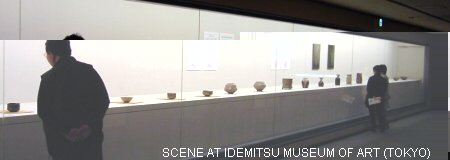|

Click here for
index to all
Yellin stories for
The Japan Times
LEARN MORE
What is
Karatsu?
|
|
|
Pots that Fired the Passion of a Magnate
TREASURES OF MOMOYAMA CERAMICS
By ROBERT YELLIN
for the Japan Times, April 14, 2004

Centuries ago, during a brief span of 30 to 40 years, one of the classic styles of Japanese pottery was born. From the end of the Momoyama Period into the early Edo Period (late 16th to early 17th centuries) nearly 300 kilns were producing wares the world knows as Karatsu-yaki.
The essence of true Karatsu pottery is found in somber wares with a wide variety of glazes ranging from earthy, buff tones to cascading, deep ocean blues. Yet Karatsu-yaki is so influential that "Karatsu" is applied generically to a broad range of pots made across western Japan. (An equivalent from eastern Japan would be Seto-mono.)
There are many famous collections of Karatsu ware in Japan, but none as extensive as the Idemitsu Museum of Art's collection in Tokyo, which is comprised of more than 300 pieces. Karatsu fans across the nation have been flocking to "Ko-Garatsu: Treasures of Momoyama Ceramics," the Idemitsu's current exhibition, showing until May 30, 2004.
It's no exaggeration to say this exhibition of 200 works is the finest Ko-Garatsu (ko means "old") exhibition ever. It draws mainly on the Idemitsu collection, but there are also some treasured pieces on loan from the famous Tanakamaru collection, one of the finest in Japan of Kyushu ceramics, now housed in a private museum in Hakata, Fukuoka Prefecture. Some of the works on display haven't been shown in public for 50 years.
The Idemitsu collection was started in 1939, when oil magnate Idemitsu Sazo (1888-1981) laid eyes upon a Ko-Garatsu chawan with a circle and cross design. His passion ignited, Idemitsu went on to collect more than 90 Ko-Garatsu tea bowls, of which dozens are on display in the current exhibition, including the famous one that started it all.
For the most part, Ko-Garatsu chawan are dignified, having about them an air of quiet confidence that lends itself to thoughtful contemplation -- all characteristics that perfectly suit Zen-inspired tea.
The Karatsu style that most accurately displays these traits is known as Oku-Gorai, a Korean-influenced style (Karatsu-yaki is a hybrid of Korean, Chinese and Japanese methods) that has won praise since the Edo Period. Oku-Gorai chawan have a full, ripe form, an often crackled, undecorated ochre-glazed body and unglazed foot.
Three famous Oku-Gorai chawan -- known as Aki-no-yo (Autumn Night), Miyamaji (Path Into Deep Mountains) and Sampo (Stroll) -- are shown for the first time under one roof in this exhibition. Though the first two of these are notable for their inclusion in an Edo Period list of chawan called the "Unshu Inventory," be warned -- the aesthetics here will not jump out at you at all, unlike Ninsei's chawan reviewed in this column last month. It's best to view these Oku-Gorai chawan with a silent mind and ask questions later; only then will their inherent beauty open up to you.
Another major Karatsu style on display is E-Garatsu, the e (meaning "picture") referring to the iron-underglaze paintings of reeds, geometric patterns, or even figurative scenes such as a farmer crossing a bridge. E-Garatsu marks the first time such iron-underglaze decoration was used in Japan.
Chosen-Garatsu, yet another style, is at once ethereal and murky thanks to its two overlapping glazes. On top of an iron glaze the potter would ladle a white glaze and the two often blended together to create riveting blues. Looking at the astonishing vitality on these clay jars, it's hard to believe they were made 400 years ago -- they prefigure the techniques of action painting, as the two glazes crisscross in enlightened patterns.
Karatsu with only the white glaze (made from rice-straw ash and feldspar) is called Madara-Garatsu. This is often found on chawan and sake utensils, with the latter being a connoisseurs' delight, as the glaze and form create the perfect "pool" for sake.
Vessels for serving food are also numerous, and on show we find spouted pouring bowls (katakuchi), delightfully tall "food cups" (mukozuke), dishes, large platters (o-zara, another Japan first), pitchers (suichu) and sake bottles (tokkuri). Many of these vessels were shipped off to Osaka and nearby Sakai as the emerging wealthy class there often held parties and picnics for which they required an array of wares.
Ko-Karatsu, like Ko-Bizen and Ko-Shigaraki, has touched the hearts and lives of ceramic lovers everywhere, and continues to inspire potters today. Ko-Karatsu also points us toward forms in which beauty and functionality combine to enrich our lives. That is the true timeless beauty of Ko-Karatsu.
DIRECTIONS TO IDEMITSU MUSEUM OF ARTS
The Idemitsu Museum of Arts is located on the ninth floor of the Teigeki Bldg, 3-1-1 Marunouchi. It's a short walk from JR Yurakucho Station -- follow the road next to the International Forum, heading toward the Imperial Palace. Admission 800 yen. Open 10 a.m. to 5 p.m.; closed Mondays.
If the Idemitsu show inspires you to purchase some Karatsu for yourself, make your way to Shibuya. There, Munehiko Maruta, a contemporary Karatsu potter of great acclaim, is showing works at Shibuya Kuroda Toen (Shibuya 1-16-14; [03] 3499-3225), April 16 to 27, 2004.
The Japan Times: April 14, 2004
(C) All rights reserved
LEARN MORE
|
|
|